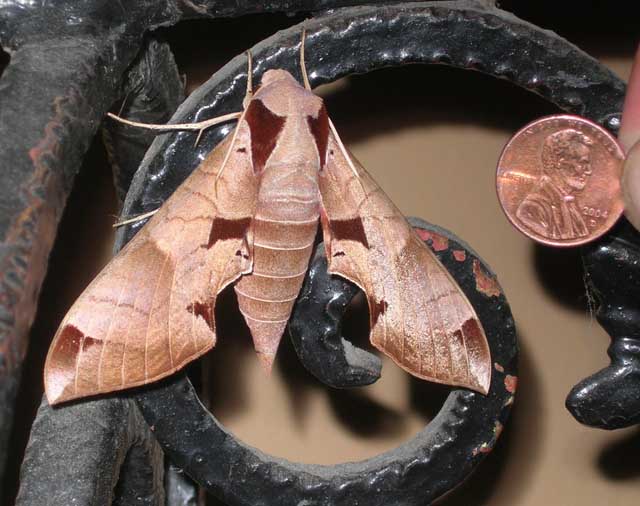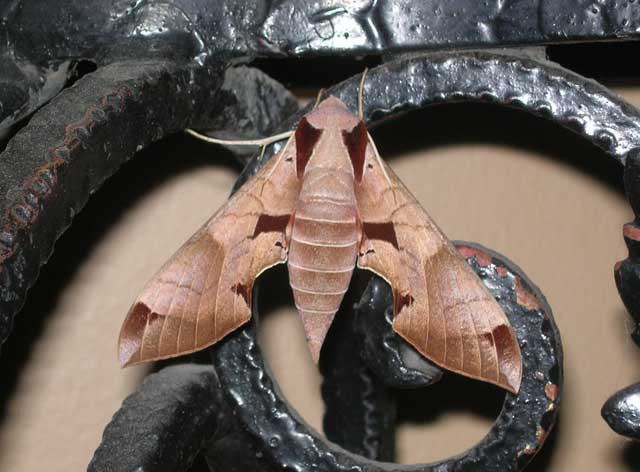Arapahoe County, Colorado
Sphingidae

Eumorpha achemon, Greenwood Village, Arapahoe County, Colorado,
July 8, 2010, courtesy of Mary Anne Shube.
|
|
Updated as per James P. Tuttle's The Hawk Moths of North America, July 10, 2010 Updated as per personal communication with Mary Anne Shube (Eumorpha achemon, Greenwood Village, July 8, 2010); July 10, 2010 Updated as per Butterflies and Moths of North America, formerly USGS, July 10, 2010 Updated as per personal communication with Jeff Kron (Eumorpha achemon, Greenwood Village, July 17, 2012); July 18, 2012 |

Eumorpha achemon, Greenwood Village, Arapahoe County, Colorado,
July 8, 2010, courtesy of Mary Anne Shube.
This site has been created by
Bill Oehlke at oehlkew@islandtelecom.com
Comments, suggestions and/or additional information/sightings are welcomed by Bill.
This page is inspired by and dedicated to
Mary Anne Shube who sent the images of the Eumorpha achemon
at top and botton of this page.
Mary Anne writes July 9, "Hi There, Bill,
"We found this moth in the front hall of our house tonight, July 8,
2010 in Greenwood Village, Colorado, which is 10 minutes south of
Denver.
"The moth was resting on the iron base of a table. It was the color
brown of a dried oak leaf, not the green color of a pandora Sphinx
moth, but the shape was the same as the pandora sphinx. My son held a
penny next to it to provide some perspective on its size. It was
amazing! We scooped it into a cup and let it go outside.
"What kind of moth is this? Is it invasive? We have a huge garden of
perennial flowers. Was letting it go the best thing to do?
"Thanks for your help."
I replied, "Hi Mary Anne,
"Very nice picture!
"It is Eumorpha achemon, the Achemon Sphinx, a close relative of Eurmorpha pandorus.
"They are widespread in Colorado and in much of USA. Letting it go was fine.
"I would like permission to post image, credited to you, to Arapahoe County pictoral checklist I am going to create."
Thirty-three Sphingidae species are listed for Colorado on the U.S.G.S. website. Not all of the species are reported or anticipated in Arapahoe County (fifteen are reported on U.S.G.S. as of July 2010). It is hoped that this checklist, with the thumbnails and notes, will help you quickly identify the moths you are likely to encounter.
A "WO" after the species name indicates that I (William Oehlke) expect that this moth is present or might be present, although unreported. A "USGS" indicates the moth is confirmed on USGS site.
Please help me develop this list with improved, documented accuracy by sending sightings (species, date, location), preferably with an electronic image, via email to Bill Oehlke.
Sphinginae subfamily
Smerinthini Tribe:
Macroglossinae subfamilyDilophonotini tribe:
Philampelini tribe:
Eumorpha achemon, Greenwood Village, July 17, 2012, Jeff Kron. Macroglossini tribe:
|

Eumorpha achemon, Greenwood Village, Arapahoe County, Colorado,
July 8, 2010, courtesy of Mary Anne Shube.
Use your browser "Back" button to return to the previous page.
This page is brought to you by Bill Oehlke and the WLSS. Pages are on space rented from Bizland. If you would like to become a "Patron of the Sphingidae Site", contact Bill.
Please send sightings/images to Bill. I will do my best to respond to requests for identification help.